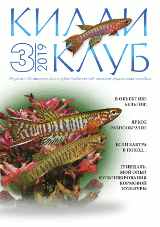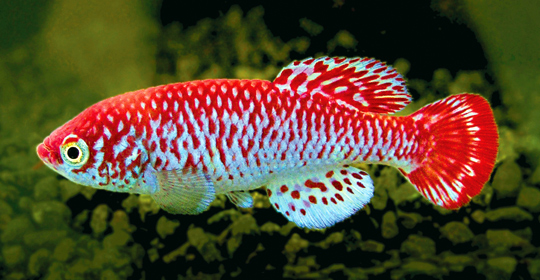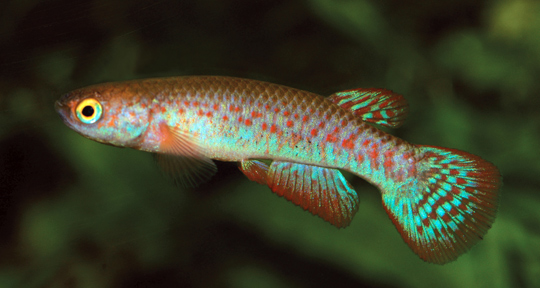Новости систематики 2012

Costa, W.J.E.M. (2012): Simpsonichthys margaritatus, a new seasonal miniature killifish from the upper Parana River basin, central Brazilian Cerrado (Cyprinodontiformes: Rivulidae).
Ichthyological Exploration of Freshwaters, 22 (4) [2011]: 313-318.
http://www.pfeil-verlag.de/04biol/pdf/ief22_4_03.pdf
В двух словах, вид близок к S. cholopteryx, который в свою очередь близок к S.parallelus
- Для комментирования войдите или зарегистрируйтесь
Новые обсуждения форума
- Выставки Killi в 2025 году (РЕЗУЛЬТАТЫ)
- Предновогодняя встреча 2024.
- Выставки Killi в 2024 году (РЕЗУЛЬТАТЫ)
- Февральская встреча 9 числа
- Поздравляем!
- Астролебиасы (Austrolebias)
- Лягушатники - тоже люди?
- Выставки Killi в 2023 году (РЕЗУЛЬТАТЫ)
- Sergejam Dzim?anas Diena!
- "Моно" аквариум самосевом.
- Общая выставка с нашим участием.
Активные обсуждения форума
- Выставки Killi в 2025 году (РЕЗУЛЬТАТЫ)
- Продам эпиплатис Дагета .
- Предновогодняя встреча 2024.
- "Моно" аквариум самосевом.
- Выставки Killi в 2024 году (РЕЗУЛЬТАТЫ)
- Общая выставка с нашим участием.
- Февральская встреча 9 числа
- Сведения о биотопах
- Александр Сухов с днём рождения!
- Поздравляем!
- Астролебиасы (Austrolebias)
Новые записи в блогах
- Всем привет. Немного психотерапии для нашего сообщества
- Epiplatys dageti
- Один из способов фотографирования килли
- Fundulopanchax walkeri spurelli
- N. Rachovii
- Aphyosemion australe фото дня
- Fundulopanchax gardneri "Gold" фото дня
- Аквариумные Аплохейлусы
- Разведение Fundulopanchax gardneri nigerianus
- Про выставку аквариумных рыб


Melanorivulus pindorama, a new killifish
from the Tocantins River drainage, central Brazilian Cerrado
(Cyprinodontiformes: Rivulidae)
Wilson J. E. M. Costa*
http://www.pfeil-verlag.de/04biol/pdf/ief23_1_10.pdf
Description of Scriptaphyosemion wieseae
(Cyprinodontiformes: Nothobranchiidae),
a new species from northern Sierra Leone
Rainer Sonnenberg & Eckhard Busch
http://zoologicalbulletin.de/BzB_Volumes/Volume_61_1/013_028_BzB61_1_Son...
Aphyosemion pseudoelegans (Cyprinodontiformes: Nothobranchiidae),
a new killifish species from the Cuvette centrale in the Congo Basin
(Democratic Republic of Congo)
Rainer Sonnenberg & Jouke R. Van der Zee
http://zoologicalbulletin.de/BzB_Volumes/Volume_61_1/003_012_BzB61_1_Son...
Nothobranchius niassa (Cyprinodontiformes: Nothobranchiidae),
a new species of annual killifish from northern Mozambique.
Stefano Valdesalici, Roger Bills, Alexander Dorn, Kathrin Reichwald
and Alessandro Clearing
http://www.pfeil-verlag.de/04biol/pdf/ief23_1_04.pdf
Geographic distribution, habitat, colour pattern variability and synonymy
of the Amazon killifish Melanorivulus schuncki (Cyprinodontiformes: Rivulidae)
Pedro H. N. Braganсa, Pedro F. Amorim and Wilson J. E. M. Costa
http://www.pfeil-verlag.de/04biol/pdf/ief23_1_08.pdf
Как я понимаю, этим материалом Melanorivulus albae признается младшим синонимом Melanorivulus schuncki, т.е. вид Melanorivulus albae можно закрывать?
Stefano Valdesalici: Nothobranchius kardashevi and Nothobranchius ivanovae (Cyprinodontiformes: Nothobranchiidae): two new annual killifishes from the Katuma River drainage, western Tanzania, pp. 191-198


aqua, International Journal of Ichthyology Volume 18, Issue 4
Abstract
Two new annual killifish species, Nothobranchius kardashevi, new species, and N. ivanovae, new species, are described based on specimens collected in ephemeral pools in the Katuma River drainage system, western Tanzania. Nothobranchius kardashevi, new species, belongs to the N. ugandensis species group and N. ivanovae to the N. taeniopygus species group. Both are distinguished from the respective other group members by a diagnostic combination of male colouration and morphological characters.
F. B. M. Vermeulen, W. H. Suijker and G. E. Collier: Laimosemion paryagi (Cyprinodontiformes: Aplocheiloidei: Rivulidae), a new species from the upper Mazaruni river drainage of Western Guyana, pp. 181-190

aqua, International Journal of Ichthyology Volume 18, Issue 4
Abstract
Laimosemion paryagi, new species, is described from the upper Mazaruni river system, a tributary of the Essequibo River. It is a member of the Laimosemion breviceps group former known as the Rivulus breviceps group, and shares a robust body and deep caudal peduncle with Laimosemion breviceps (Eigenmann, 1909) and Laimosemion lyricauda (Thomerson et al., 1991) and to a lesser degree with L. gransabanae (Lasso et al., 1992) and Laimosemion torrenticola (Vermeulen & Isbrucker, 2000). These species are all endemic to the Guiana Highlands in western Guyana and the neighbouring Gran Sabana in Eastern Venezuela. It is distinguished from other species in the L. breviceps group by morphology and its remarkable male color pattern of red blotches on a turquoise ground color on the flanks and in the unpaired fins and having a rounded caudal fin as opposed to one having extension or being spade shaped. Analysis of mitochondrial DNA sequence reveals that it is genetically distinct from all other members of this group and that inhabitants of the Guyana highlands diverged from each other early in the history of the genus, commensurate with the geological age of the Guiana Shield.
А кто эти Kardashev and Ivanov ?
Это два болгарина, Кирил Кардашев и Ива Иванова, они эти два вида и выловили
Спасибо Максим, просветил. А то я уже подумал что ученый мир Кардашева с Торгашевым перепутал . Сравнил карты двух экспедиций - наши ребята ведь совсем рядом были. Хотя "совсем рядом" по африканским меркам это может быть несколько десятков километров.
. Сравнил карты двух экспедиций - наши ребята ведь совсем рядом были. Хотя "совсем рядом" по африканским меркам это может быть несколько десятков километров.
Так хотелось бы,что бы и наши научные умы наконец взялись за ум(я думаю,что все понимают кого я имею ввиду) и описали N.sp.TSTS 10-05. Лично я считаю,что он один на ряду из самых ярких открытий нотобранхиусов за последнее время. Да и название напрашивается само собой. :YES:
A new species of annual fish, Hypsolebias tocantinensis sp.n. (Cyprinodontiformes:Rivulidae) from the rio Tocantins basin, northeastern Brazil
DALTON TAVARES BRESSANE NIELSEN, JO?O CARLOS CRUZ & ARS?NIO CALDEIRA BAPTISTA JUNIOR (Brazil)
Zootaxa 3527: 63–71 (26 Oct. 2012) 7 plates; 13 references Accepted: 13 Sept. 2012
Hypsolebias tocantinensis n. sp. is described from a temporary pool located in the rio Tocantins basin, Maranhao state Brazil. Hypsolebias tocantinensis belongs the H. flammeus species-group. It is the first occurrence of genus Hypsolebias in Maranhao state. This new species differs from all other species of that group, except Hypsolebias flammeus (Costa, 1989), Hypsolebias multiradiatus (Costa &Brasil, 1994) and Hypsolebias brunoi (Costa, 2003), by male color pattern and by the presence of a metallic blue sheen surrounding the black spots in the female. It differs from H. flammeus, H. multiradiatus and H. brunoi by the shape of the dorsal and anal fins (rounded vs. pointed) and by the orientation of the reddish brown bars in males (diagonal vs. vertical). Hypsolebias tocantinensis differs from all other Hypsolebias by the presence of, in females, irregular light brown stains on the anal fins and by the pattern of the metallic blue sheen around the black spots (completely surrounding the black spots while in congeners this blue sheen is either absent or present in vertical bars).
Если кратко, то новый вид почти ничем не отличается от других видов группы H. flammeus
new species Melanorivulus ubirajarai and Melanorivulus kunzei
Costa, W.J.E.M. (2012): Two new species of Melanorivulus from the Caiap?s hill, upper Araguaia river basin, Brazil (Cyprinodontiformes: Rivulidae).
Melanorivulus kunzei Costa, 2012
Melanorivulus ubirajarai Costa, 2012
Ichthyological Exploration of Freshwaters, 23 (3): 211-218.
http://www.pfeil-verlag.de/04biol/pdf/ief23_3_02.pdf